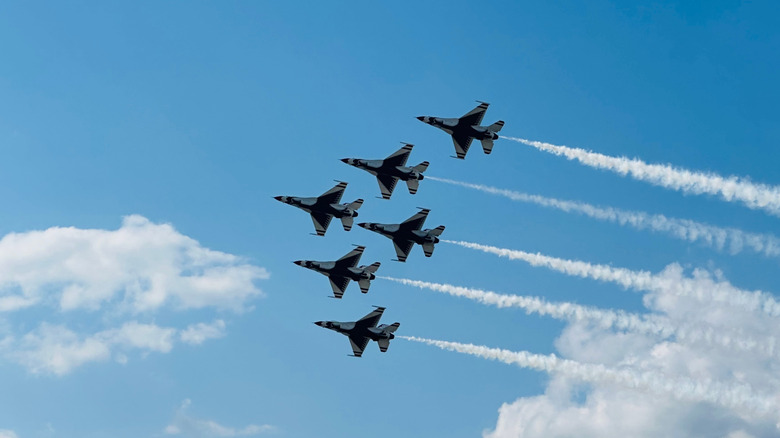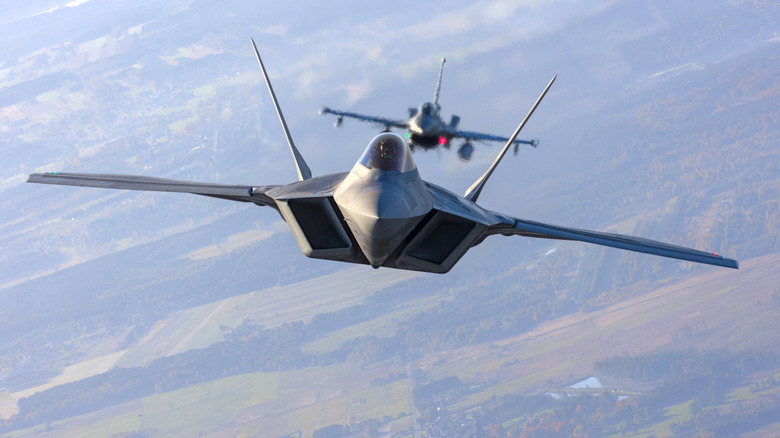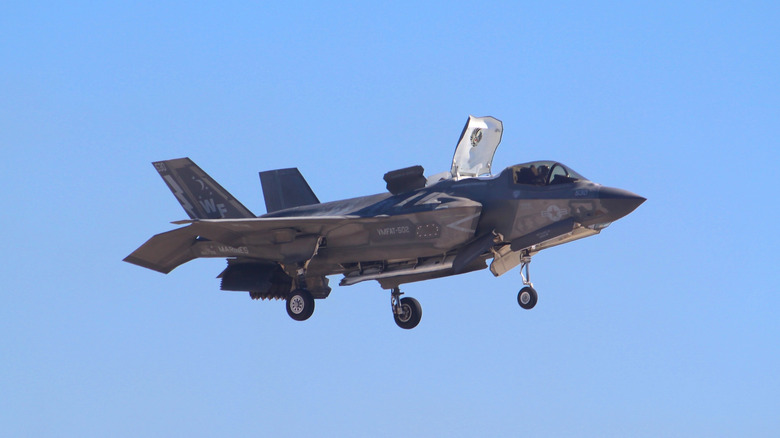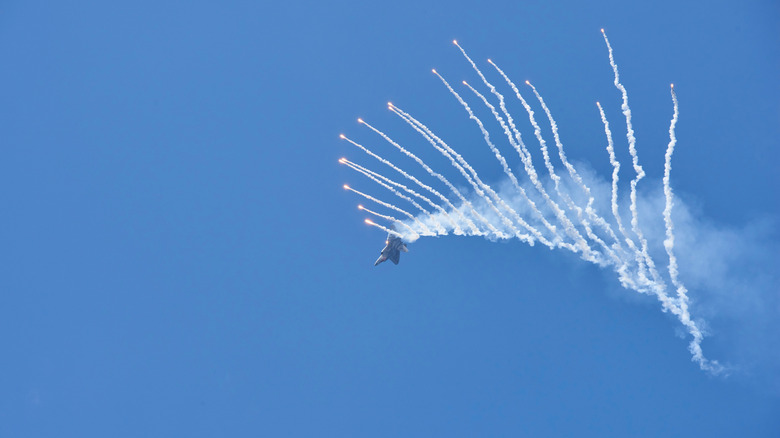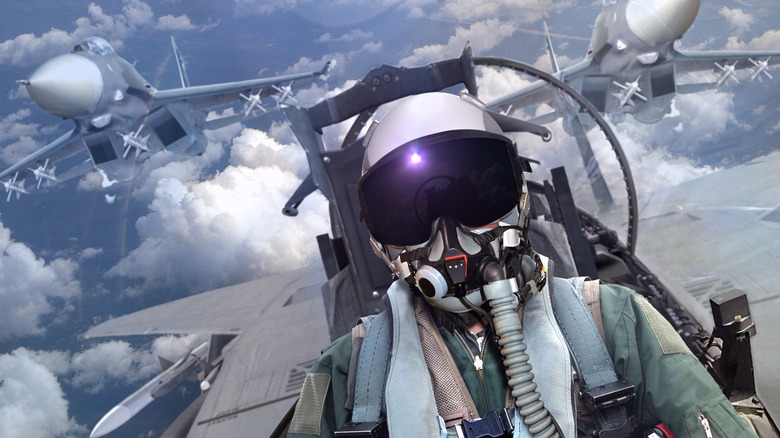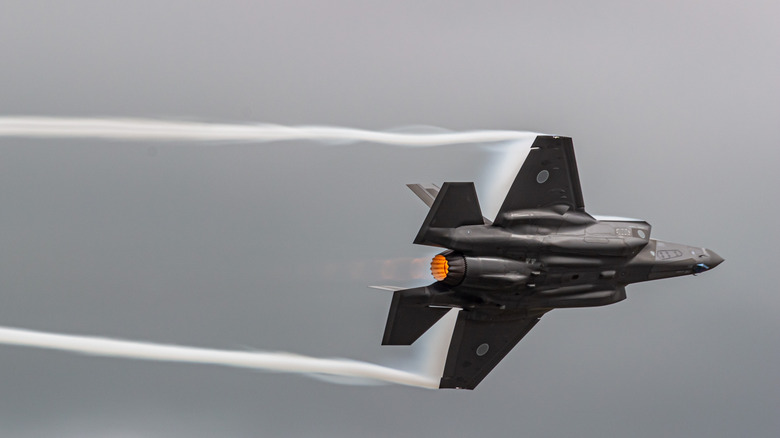6 Fighter Jet Myths You See On TV And In Movies
In the world of fiction, the rule of cool trumps all. Cars in video games can go faster and endure stunts and crashes that would total real cars, whereas computer hacking in movies is a much more dynamic and action-packed activity than in real life. This trend also extends to military vehicles in television and movies (and video games), especially fighter jets.
Unless you actually build, maintain, or pilot jet planes, there is a 99% probability you have no idea how they work. These vehicles are so complex that it takes years to learn how to maintain them properly, and even longer to operate them safely. You can't just walk into a DMV, take a test, and walk out with a fighter jet license. This general lack of public knowledge affords many filmmakers and showrunners enough leeway to write jets with unrealistic capabilities that cater to the plot without ruining the suspension of disbelief for many viewers. However, by that same token, these movies and shows instill incorrect knowledge of these planes' capabilities, as they are often the viewers' only source of information.
Unless you actually work with fighter jets, you might never pick out the inconsistencies between their fictional depictions and the real deal. But then again, you're currently reading an article that does that for you. Read on if you want to learn exactly how unrealistically many movies and TV shows (and video games) depict fighter jets.
Fighter jet travel long distances
Air travel is ubiquitous in modern life, especially when time is of the essence. If you want to get somewhere fast and possibly far away, you take a plane. A trip that would typically take 10 hours by car may only take 2 hours by jet. Plus, planes soaring across the Atlantic and Pacific oceans are daily occurrences. It's just that fighter jets aren't among their ranks.
The most obvious myth movies and shows perpetrate about fighter jets is, quite frankly, the same myth they spread about all vehicles in general: Entertainment can never get the range right. Movies and shows often show planes (and cars) capable of traveling a semi-infinite distance on one tank of gas. Take, for instance, "Wonder Woman 1984." A bad movie, yes, but in that film, Steve Trevor and Diana steal a jet – supposedly an F-111 Aardvark – in Washington, D.C., and fly it all the way to Cairo, Egypt.
For those who don't know, the distance between Washington, D.C., and Cairo is over 5,800 miles. That is more than doable by transatlantic jets, but not an F-111 Aardvark. Those planes only had a max distance of just over 3,600 miles. A real F-111 Aardvark would have plopped Steve and Diana into the ocean just off the coast of Africa. And not even modern planes like the F-16 can travel that far. Admittedly, expecting realism from a DC film is a tall order, but that was only one example out of countless.
Fighter jets buzz targets
Fighter jets are a spectacle unto themselves. Nothing screams America quite like attending a football game and having your eardrums blown out by fighter jets flying several hundred feet overhead during the Pledge of Allegiance. While this flight maneuver puts on a show, it isn't strategically viable in any other situation.
Whenever movies show fighter jets engaging or even attacking targets, they often have CGI planes extremely close to the ground, soldiers, or their quarry. This is doubly true when CG monsters are involved. In "Godzilla vs. Kong," fighter pilots don't open fire until they're within a few hundred feet of Godzilla's dorsal plates, and to add insult to injury, the jets only annoy him before running headlong into his tail. And in "The Tomorrow War," the fighter jets called in to pull off an air strike are probably 100 feet off the ground when they show up in the combat zone.
While these maneuvers put on a good show for the audience — and give writers an easy excuse to have the planes destroyed seconds later — they aren't necessary in the real world. Many missiles carried by fighter jets have significant ranges. They're often classified, but it's reasonable to assume they can fly a mile or more. After all, F-35 Lightning II jets can carry mini-nukes, and buzzing a target you just atomized with 340 kilotons of explosive force is a great way to get yourself killed. In the real world, there is no legitimate reason to get in close with a fighter jet.
VTOL jets can hover
VTOL fighter jets are a miracle of modern aeronautics. Unlike standard fighter jets, VTOLs need significantly less runway distance to launch and land. This design gives them more freedom for deployment than other planes. However, VTOLs are significantly rarer, so to the average person, they might as well run on magic.
How do you tell if a VTOL is in a movie or TV show? Simple: It hovers. You can see these in movies such as "True Lies" and "Live Free or Die Hard," where jets hover over a single point with zero forward momentum. These planes can even strafe left and right without losing sight of their targets, not unlike UFOs.
The logic behind these film and TV scenes is self-explanatory. If VTOL jets can take off vertically, then they must logically be able to hover. That and firing guns from a fighter jet gets the adrenaline pumping. In reality, VTOL takeoffs are difficult maneuvers. Once the plane lifts into the air, it can only transfer to forward movement. These jets don't have any thrusters or mechanisms that would allow for maneuvers resembling what VTOLs can pull off in movies and shows. Fighter jets can carry out strafing runs, but those involve flying past the target while firing, which is a far cry from strafing left to right like a fictional VTOL.
Flares are a catch-all missile countermeasure
Modern fighter jets can be equipped with a small armory's worth of weapons. Not all at once, mind you, but these armaments let planes fill a wide variety of roles, including shooting down other fighter jets. Of course, every jet also needs to include some countermeasures against these weapons.
Whenever you see missiles in movies, TV shows, or video games, they have target lock and tracking capabilities. Pilots just fire and watch the internal systems do all the accuracy work for them. Dodging and weaving will only stave off an impact for so long, so pilots often deploy flares to mess with tracking systems. Even when a character flies something other than a fighter jet, such as an armor suit as Tony Stark does in "Iron Man," they deploy flares when their radar says a missile locks onto them. Except not all missiles work that way.
In reality, air-to-air missiles are divided into two categories: infrared-guided and radar-guided. Infrared missiles home in on the hottest object they can find — usually a jet engine's jet exhaust — while radar-guided missiles are attracted to the emanations from radar systems. Fighter jets shoot out flares to confuse IR missile systems, but these weapons don't trigger radar lock warnings, just like how flares don't trick radar-seeking missiles. In reality, radar-homing missiles are countered with chaff, a fine cloud of thin aluminum and metallized glass that confuses radars. Despite what movies tell you, flares aren't a catch-all countermeasure.
Hot shot and lone wolf pilots win the day
Hollywood movies thrive on clichés. The last person alive in a slasher film is often a woman. A weapon or item introduced in the first act will be used in the final act. The best fighter pilots are people the audience can relate to. However, they also exhibit many characteristics that would get them kicked out of flight school.
Nine times out of ten, the best pilots in a movie, fighter or otherwise, are the hot shots and lone wolves who refuse to do things by the book, don't play well with others, and question authority. That is basically Pete "Maverick" Mitchell's personality in "Top Gun." Of course, Maverick undergoes character development in the film, but that is more for his willingness to work in a team than his skill or attitude.
In the real world, you would be hard pressed to encounter a more rigidly disciplined person than a fighter pilot. Dedication to teamwork is a key trait, as military pilots seldom fly alone. They are often in the air with at least one wingman, if not in formations of multiple wingmen. Plus, they need to have preternatural concentration to keep an eye on all of their systems while remaining conscious when rocketing through the air at Mach speeds. Real pilots can't afford to be hot shots, because being one is a fast way to get someone killed.
Afterburners are always on
Movies and TV shows thrive on exaggeration. Subtlety is often lost on the viewers, especially when they don't know something is happening, when they don't actually see anything happening on screen. Sometimes the FX team needs to add a little extra to get the point across, no matter how unrealistic it may be.
Whenever you see a fighter jet's engines in a TV show or movie, more often than not, you see them lit up or even spouting fire. You can find this in films such as "Wonder Woman 1984" and "Transformers," and even fighter jets in video games and their respective trailers have illuminated engines. These lights help indicate that the engines are on, even though that's not what they're supposed to do.
Real jet engines only light up when pilots activate the afterburner. This feature dumps extra fuel into the engine. The additional fuel continues to burn even as it exits the engine through the exhaust, producing a highly noticeable gout of flame. Since afterburners are far from fuel efficient, real pilots use them sparingly, usually for a burst of speed or during takeoff. Leaving the afterburner on is a great way to empty a jet fighter's fuel reserves. Movies such as "Top Gun: Maverick" get the relationship between afterburners and flaming engine exhausts right, but they are few and far between, and highlight just how many get it wrong.
